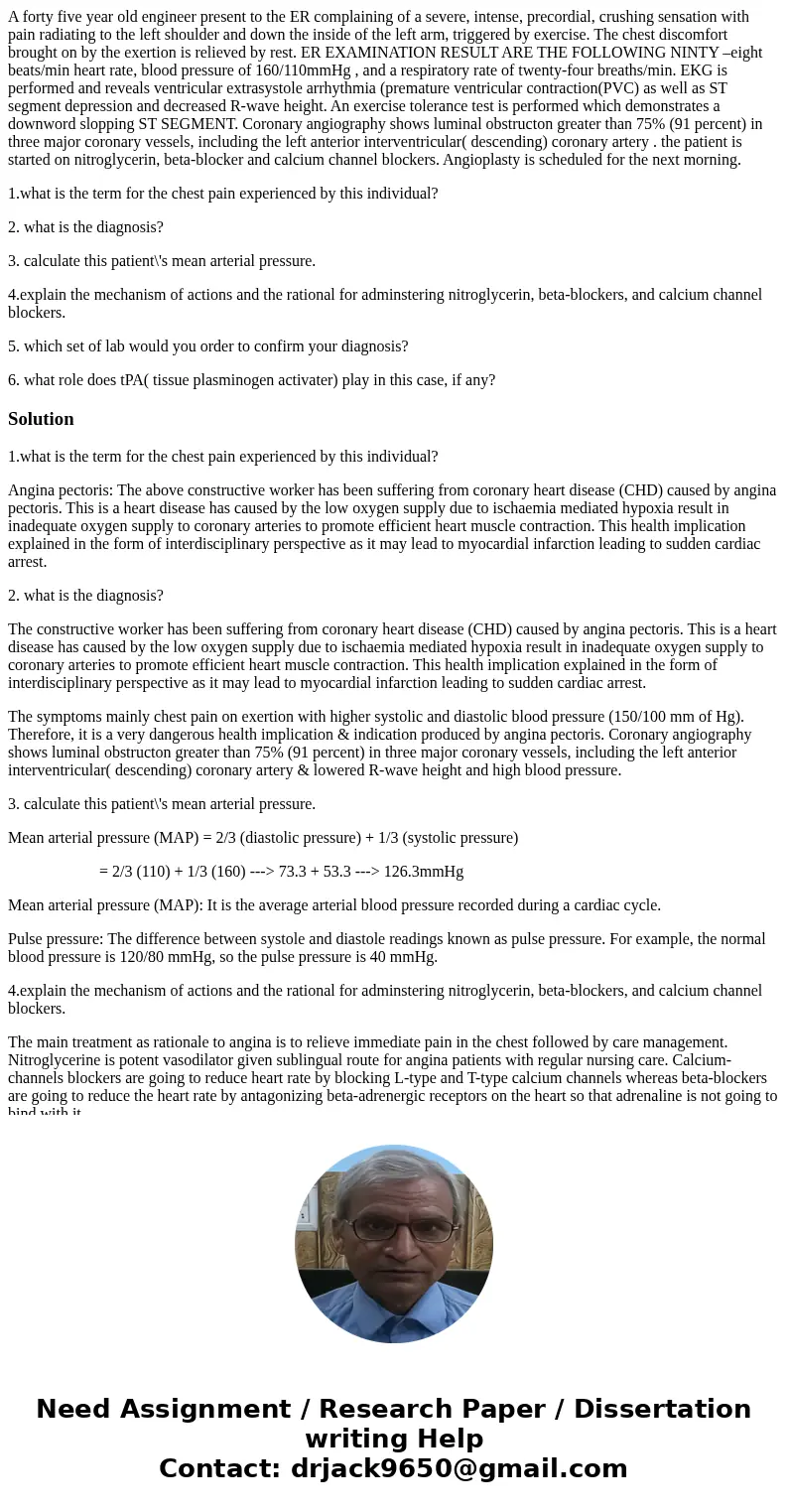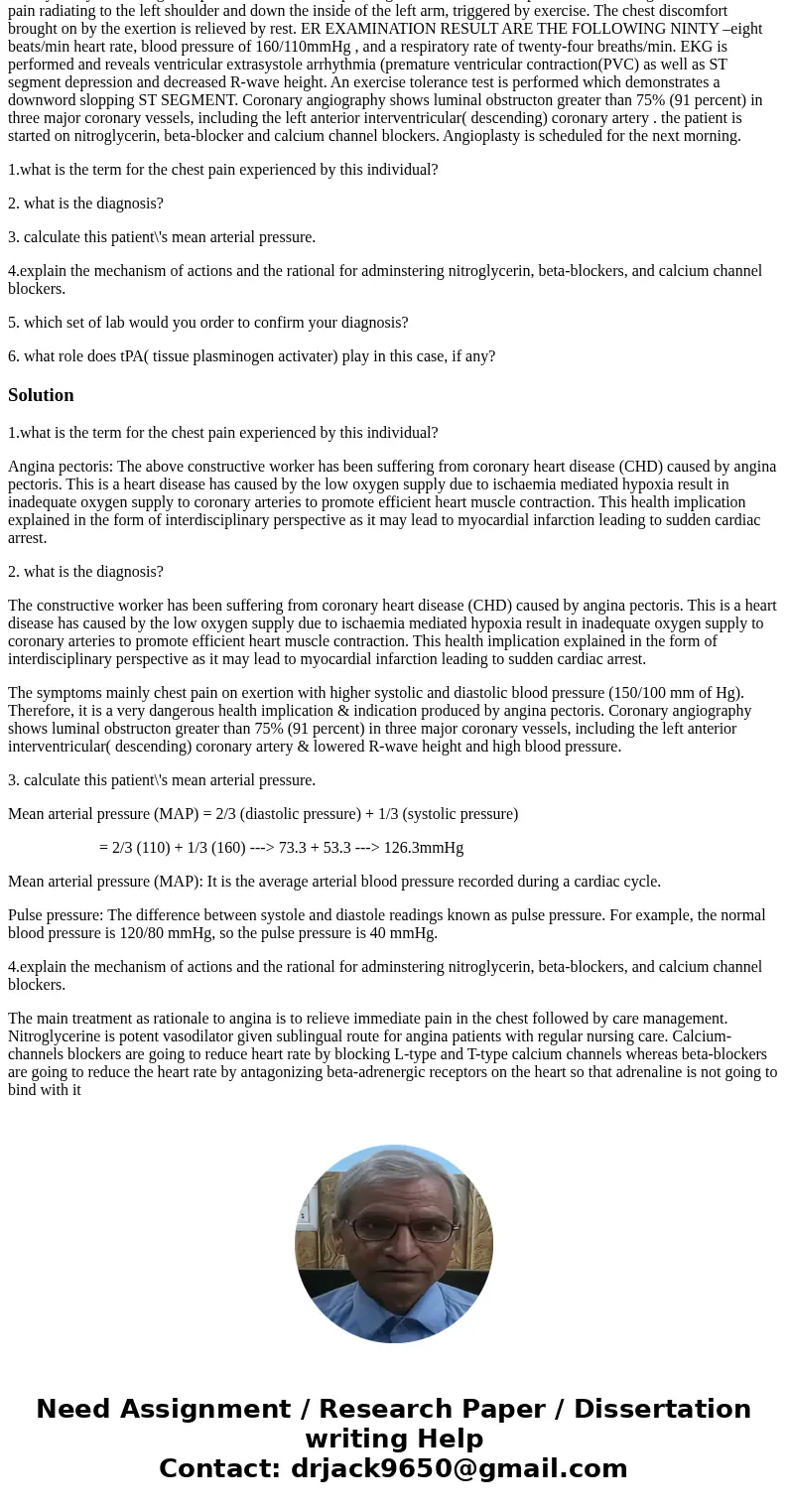A forty five year old engineer present to the ER complaining
A forty five year old engineer present to the ER complaining of a severe, intense, precordial, crushing sensation with pain radiating to the left shoulder and down the inside of the left arm, triggered by exercise. The chest discomfort brought on by the exertion is relieved by rest. ER EXAMINATION RESULT ARE THE FOLLOWING NINTY –eight beats/min heart rate, blood pressure of 160/110mmHg , and a respiratory rate of twenty-four breaths/min. EKG is performed and reveals ventricular extrasystole arrhythmia (premature ventricular contraction(PVC) as well as ST segment depression and decreased R-wave height. An exercise tolerance test is performed which demonstrates a downword slopping ST SEGMENT. Coronary angiography shows luminal obstructon greater than 75% (91 percent) in three major coronary vessels, including the left anterior interventricular( descending) coronary artery . the patient is started on nitroglycerin, beta-blocker and calcium channel blockers. Angioplasty is scheduled for the next morning.
1.what is the term for the chest pain experienced by this individual?
2. what is the diagnosis?
3. calculate this patient\'s mean arterial pressure.
4.explain the mechanism of actions and the rational for adminstering nitroglycerin, beta-blockers, and calcium channel blockers.
5. which set of lab would you order to confirm your diagnosis?
6. what role does tPA( tissue plasminogen activater) play in this case, if any?
Solution
1.what is the term for the chest pain experienced by this individual?
Angina pectoris: The above constructive worker has been suffering from coronary heart disease (CHD) caused by angina pectoris. This is a heart disease has caused by the low oxygen supply due to ischaemia mediated hypoxia result in inadequate oxygen supply to coronary arteries to promote efficient heart muscle contraction. This health implication explained in the form of interdisciplinary perspective as it may lead to myocardial infarction leading to sudden cardiac arrest.
2. what is the diagnosis?
The constructive worker has been suffering from coronary heart disease (CHD) caused by angina pectoris. This is a heart disease has caused by the low oxygen supply due to ischaemia mediated hypoxia result in inadequate oxygen supply to coronary arteries to promote efficient heart muscle contraction. This health implication explained in the form of interdisciplinary perspective as it may lead to myocardial infarction leading to sudden cardiac arrest.
The symptoms mainly chest pain on exertion with higher systolic and diastolic blood pressure (150/100 mm of Hg). Therefore, it is a very dangerous health implication & indication produced by angina pectoris. Coronary angiography shows luminal obstructon greater than 75% (91 percent) in three major coronary vessels, including the left anterior interventricular( descending) coronary artery & lowered R-wave height and high blood pressure.
3. calculate this patient\'s mean arterial pressure.
Mean arterial pressure (MAP) = 2/3 (diastolic pressure) + 1/3 (systolic pressure)
= 2/3 (110) + 1/3 (160) ---> 73.3 + 53.3 ---> 126.3mmHg
Mean arterial pressure (MAP): It is the average arterial blood pressure recorded during a cardiac cycle.
Pulse pressure: The difference between systole and diastole readings known as pulse pressure. For example, the normal blood pressure is 120/80 mmHg, so the pulse pressure is 40 mmHg.
4.explain the mechanism of actions and the rational for adminstering nitroglycerin, beta-blockers, and calcium channel blockers.
The main treatment as rationale to angina is to relieve immediate pain in the chest followed by care management. Nitroglycerine is potent vasodilator given sublingual route for angina patients with regular nursing care. Calcium-channels blockers are going to reduce heart rate by blocking L-type and T-type calcium channels whereas beta-blockers are going to reduce the heart rate by antagonizing beta-adrenergic receptors on the heart so that adrenaline is not going to bind with it


 Homework Sourse
Homework Sourse